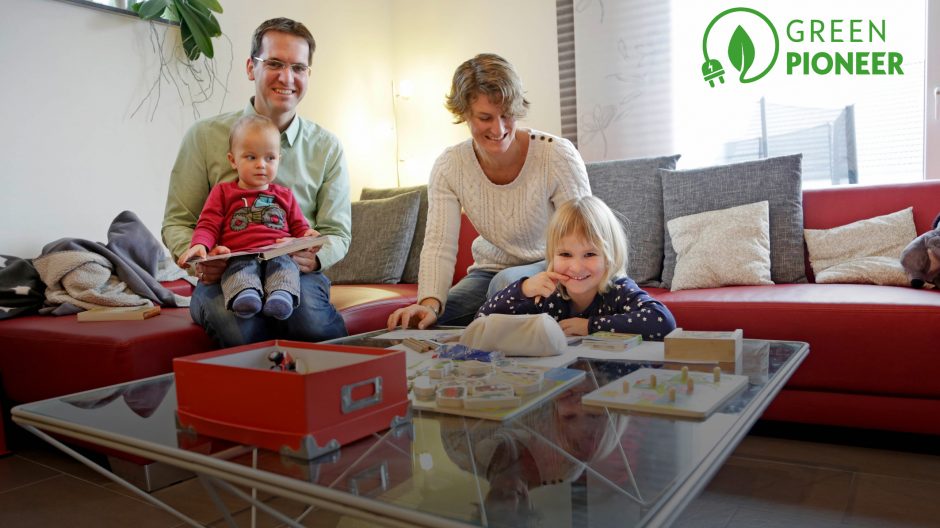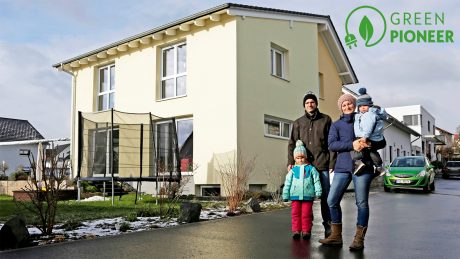- The Papes, part of the Opel family, number among today’s energy pioneers, thanks to their passive house.
“Rising energy costs have no effect on me,” says Daniel Pape with a chuckle. There’s a reason he doesn’t have to worry about them. His 160-square-meter, two-story house complete with basement, constructed in 2013, forgoes classic building heating in most of its rooms – even in winter, at frosty outdoor temperatures. Heat from the stove suffices to warm up the kitchen, while five tea lights kept burning around the living room keep things “nice and toasty, at around 21 degrees Celsius,” says Pape, an Operational Business Assistant who works on transmission and electrification at the international Development Center (ITEZ) in Rüsselsheim, Germany. This living situation might sound unimaginable to outsiders at first, reports the certified electrical engineer. However, Pape is happy to clarify: “The idea behind it is called ‘passive house.’” The 38-year-old lives inside one with his wife Pia and their two children, Mira (4) and Niklas (1), in Ober-Ramstadt, near Darmstadt, Germany. Pape finds the passive house concept to be both cost-effective and environmentally-friendly.
A look at the figures confirms his view. The Papes’ passive house requires an astounding 90 percent less energy to heat than a conventional single-family home. It even saves over 75 percent compared to an average new building. In other words, the Pape family uses an incredibly low energy content of 15 kilowatt hours (which corresponds to about 1.5 liters of heating oil) per square meter, per year. This keeps the costs of utilities at a minimum.

Opel has pledged to save energy and ensure sustainable power supply in its plants and at its sites. A vast number of measures are implemented to this end each day. However, being environmentally conscious does not do a lot of good if you only put it into practice from 9 to 5. You need to take a fundamental, all-encompassing approach. We are introducing employees who live out this approach in a special way: They are our energy pioneers.
Daniel Pape, who has been working at Opel since 2008, studied at the Technische Universität (TU) Darmstadt in the 2000s, where he first learned about the passive house concept. Dr. Wolfgang Feist, who later went on the found the Passive House Institute, built the first recognized building of this kind in Darmstadt in 1991. Pape spoke with architecture students who were highly familiar with this topic, having developed an interest in this energy-efficient way of living. “If a person acts passively, that usually isn’t a particularly desirable trait,” he says. But it’s different for buildings: “Heat never escapes in a passive house.”
“Heat never escapes in
a passive house.”
Daniel Pape, Operational Business Assistant
A number of measures work in tandem to ensure this. Firstly, the house is particularly well insulated: Insulation thicknesses of up to 40 centimeters on the outer walls, especially in the roof, supplemented by triple-glazed windows, create a nearly airtight, insulated building envelope. A ventilation system with integrated heat recovery provides fresh air. A geothermal heat exchanger is also used: Since the soil is warmer than the surrounding air in the winter and cooler than it in the summer, fresh air can be pre-warmed or pre-cooled in a highly efficient way. The used air is constantly removed from the house and replaced with fresh air; these airflows never mix. The windows can be opened, but this isn’t necessary: Every hour, the system completely replaces all of the air in the building. This comes with a pleasant side effect: “The ventilation system filters out pollen and dust. Since I have allergies, I really appreciate that,” says Pape.
The autonomous heating system is supported by a district heating network to which the new housing estate is connected. “The district heating is based on power from wooden pellets and green gas,” explains Pape. This warmth also heats up the water in the house to up to 70 degrees Celsius. For Daniel Pape, this works out perfectly. The living comfort provided by the passive house concept is priceless. Pape is currently considering mounting solar panels onto the roof’s building, which would make his home a ‘plus energy home.’
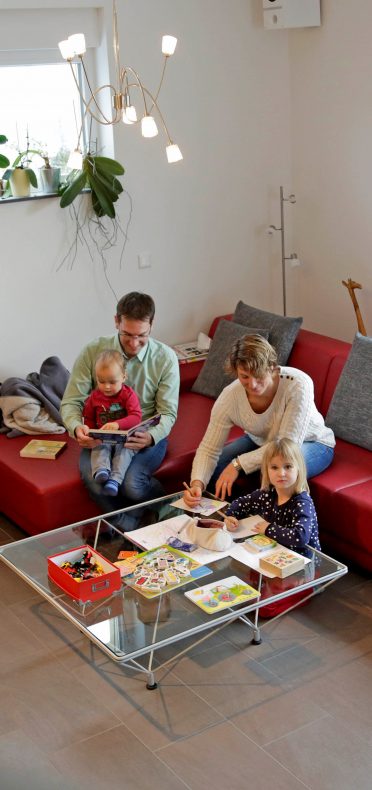
The Pape family enjoys comfortably warm temperatures in their living room – even though their passive house requires 90 percent less energy to heat than a conventional home.
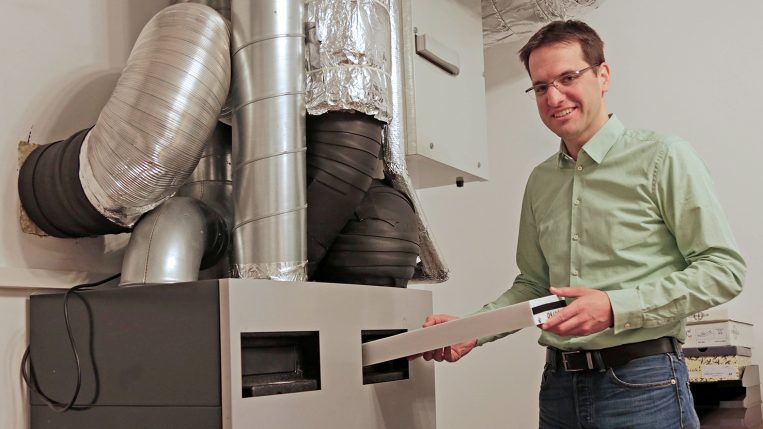
Thanks to modern technology, Daniel Pape has no need to worry about sharply increasing energy costs.
Opel actively promotes passive power generation
Creating a cozy working environment while simultaneously reducing heat energy requirements: This was also the goal behind the construction of the new Global Propulsion Systems Center in Rüsselsheim. “We rely on heat recovery of up to 75 percent for the interior ventilation systems,” explains Michael Löffler, Project Manager at Global Facilities.
This heat recovery is carried out in the seven-story workshop and office building complex through rotary heat exchangers in the supply and exhaust air volume flows of the ventilation systems. A rotary heat exchanger, also known as a rotating air-to-air heat exchanger, consists of thin aluminum foils that are wound in alternating smooth and corrugated layers, similar to corrugated cardboard. The spaces between these corrugations form air channels parallel to the rotor axis.
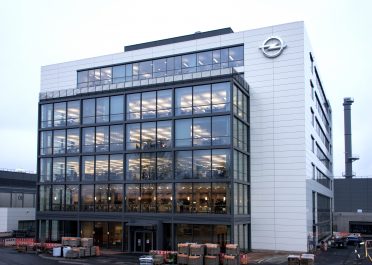
Inside the new Global Propulsion Systems Center at the Opel site in Rüsselsheim, heat recovery is guaranteed through the use of rotary heat exchangers in the supply and exhaust air volume flows of the ventilation systems.
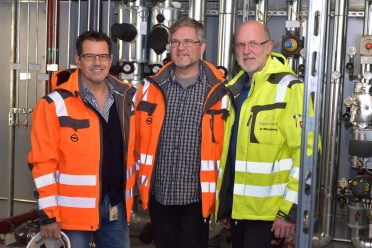
Active in the Opel passive house (from left): Michael Löffler, Project Manager at Global Facilities, Michael Balczarczyk, Head of the Technical Systems Facility Project, and Uwe Münzberg, Electronic Maintenance, in the new engine testing center.
While the warm exhaust air passes on a portion of its heat energy to the storage mass while streaming through the rotating air-to-air heat exchanger, this is used to pre-heat the outside air through the rotation of the heat exchanger. “The rotary heat exchangers we use are also coated with a sorbent that transmits the moisture from the exhaust air stream to the outer air stream, thereby reducing the energy need for air humidification during winter operation,” explains Michael Balczarczyk, Head of the Technical Systems Facility Project.
Engine testing operations also serve to further recover energy, reports Uwe Münzberg, who works in Electronic Maintenance at the new Global Propulsion Systems Center. Nearly all of the power generated by the load machines (dynamometers) is fed back into the network.

What Makes a House Passive?Houses are considered ‘passive’ when the majority of their heat requirements are covered by passive sources, such as sunshine, body heat, or technical devices. ‘Passive house’ isn’t a brand name; it’s a construction concept and a building standard. |
